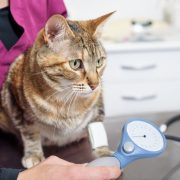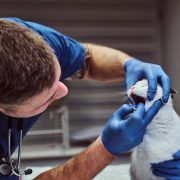The utility of combined urine dipstick analysis and specific gravity measurement to determine feline proteinuria
The utility of combined urine dipstick analysis and specific gravity measurement to determine feline proteinuria

Open Access
In our edition of: Dec 2020
In our categories of: small animals
our summary:
Pérez‐Accino, J., Feo Bernabe, L., Manzanilla, E.G. and Puig, J. (2020). The utility of combined urine dipstick analysis and specific gravity measurement to determine feline proteinuria. Journal of Small Animal Practice, 61(9) pp 541-546
The aim of this retrospective study was to assess the utility of the urine dipstick combined with urine‐specific gravity (USG) for detecting proteinuria in cats when compared with urine protein‐to‐creatinine (UPC) ratio.
Medical records of cats presenting at a single referral hospital between 2011-2017 were reviewed. To be included in the study, feline urine samples must have undergone a full urine analysis including dipstick evaluation, USG measurement and UPC determination. During the study period, all urine samples were analysed within 4 hours of collection.
Dipstick results were recorded as per the manufacturer’s scale: Negative, Trace, 1+, 2+, 3+ and 4+. Samples were classified according to their USG into one of four categories; hyposthenuric (< 1.008), isosthenuric (≥ 1.008 – ≤ 1.012), inadequately concentrated (> 1.012 and < 1.035) and concentrated (≥ 1.035). The samples were also classified according to their UPC as non‐proteinuric (< 0.2), borderline proteinuric (0.2–0.4) and proteinuric (> 0.4). Diagnostic agreement between the dipstick test result and UPC was calculated both for the dipstick test alone and when combined with the USG. A receiver operating characteristic (ROC) curve was then used to evaluate the discriminatory power of the urine dipstick test alone or when combined with USG to detect proteinuria.
A total of 121 urine samples were included in the study. Results showed a poor diagnostic agreement between dipstick and UPC; this did not improve when USG was considered alongside the dipstick. The highest dipstick sensitivity achieved was 82% (in samples that were ≥ Trace as positive with USG >1.012), dipstick specificity was poor. The positive predictive value for the dipstick alone improved slightly when interpreted together with USG for samples with USG < 1.035. The negative predictive value for the dipstick was very low in all cases. The ROC curve showed the dipstick alone to be inaccurate in detecting proteinuria.
Limitations of the study were the small number of available samples, which prevented complete data analysis in several areas, and that the interpretation of the dipstick test involved a degree of subjectivity, as this was carried out by different veterinary practitioners this was a source of potential error.
This study serves as a timely reminder that the dipstick test is not accurate for detecting proteinuria in cats and that combining the dipstick result with urine‐specific gravity had only a marginal impact on accuracy. Veterinary practitioners should not rely on this test but use other methods such as urine protein‐to‐creatinine ratio to assess protein levels in cat urine.
Image copyright attribute: Olena Vlasko
Join the discussion
We encourage discussion on all material highlighted in each edition of inFOCUS. Use the button below to join the conversation on Twitter and include your comment in the feed for this issue.







Leave a Reply
Want to join the discussion?Feel free to contribute!